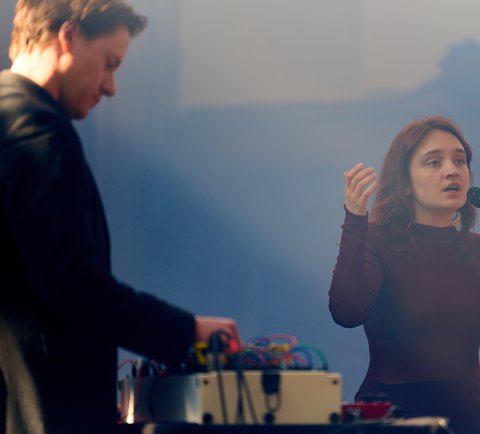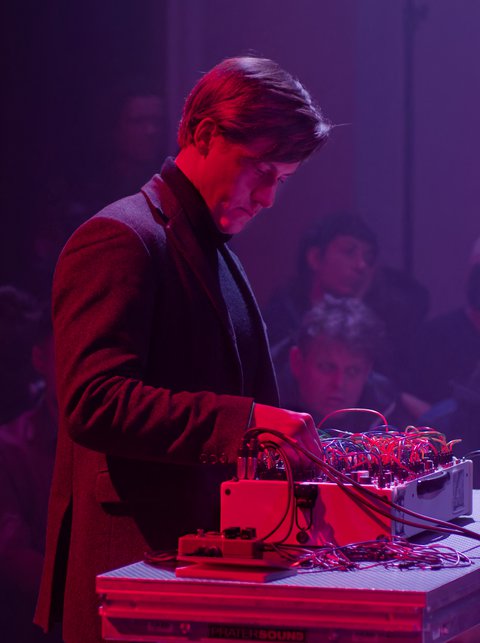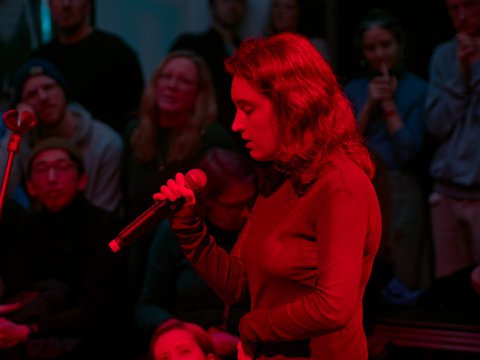Гільдеґарда (»Hildegarda«) the new album by Ukrainians Heinali & Andriana-Yaroslava Saienko released on the Unsound label on May 30. With the transformed chants from the Middle Ages, they offer a mystical festival Prologue in Bonn Minster. Here the Ukrainian Heinali, a. k. a. Oleh Shpudeiko, writes about fear in the face of bombs and the connection to 1000-year-old music.
Heinali & Andriana-Yaroslava Saienko
Hildegard’s spirit in the synthesizer

When a Russian missile struck the ground not far from my studio in Kyiv, I vividly remember how my body reacted to the explosion, milliseconds before my mind did. That traumatic explosion reduced my essence to a primal state. There existed nothing but dread – the kind that, in scripture, accompanies the appearance of angels announcing, »Be not afraid«.
The visions of Abbess, composer and mystic Hildegard von Bingen were preceded by bright, excruciating flashes of light. Modern medicine reduces them to cluster migraines, one symptom of which is the retinal aura, often accompanied by blurred vision and blind spots. Hildegard’s music can place great demands on the bodies of its performers, emphasizing uncomfortable intervals and the wide distance between the lowest and highest pitch. In comparison, Gregorian chant, the liturgical standard of the time, represents a tempered attempt to grasp God intellectually; indeed, Hildegard’s music was once described as a stick of dynamite thrown into a Gregorian chant.

This album is not a historically informed performance. Hildegard’s persona and music are a starting point – a distant mirror, akin to the shield of Perseus, used to reflect Medusa. It allows us to reflect, comprehend, externalise, and transcend traumatic wartime experience, reinstating the embodied origins of Christianity, which contained suffering but also offered the promise of transcendence. Andriana-Yaroslava Saienko emphasises this physical aspect of Hildegard’s music by drawing on authentic Ukrainian folk singing, a form that survived despite efforts by the Soviet occupation to replace it with a simulacrum that is naive, harmless, and devoid of contradictions – an attempt to ›civilise‹ the body by disembodying it.

The musical approach is also informed by my ongoing practice of reimagining early music in modular synthesis. I accompany Andriana-Yaroslava’s fiery singing with drones – extended sounds that also occurred in medieval music. The drones alternate with improvisations, one taking its starting point in medieval polyphony, the other working with the concept of the interchangeability of sound and light, referring both to Hildegard’s visions and the space in which we recorded the album: the Cistercian abbey of Sylvanès in Southern France, known for historical stained glass windows whose patterns reference the dispersion of acoustic waves inside the church.
The album features two compositions by Hildegard von Bingen: »O Ignis Spiritus Paracliti« (O Fire of the Spirit and Defender), dedicated to the Holy Spirit, and »O Tu Suavissima Virga« (O Sweetest Branch), in honour of the Virgin Mary. Both pieces are performed radically slower than usual, expanding in time and space. On vinyl, the compositions are designed to reflect one another and can be listened to in either order. In the digital edition, there is a bonus track titled »Zelenaia Dubrovonka« (The Green Oak Grove). Based on a Ukrainian folk song from the Polissia region, Andriana-Yaroslava adapted the lyrics to reflect our contemporary reality. The green oak grove does not rustle with the wind; instead, it resonates with a different sound – perhaps the missile that struck near my Kyiv studio.
Concert at the festival 2025
- , Bonner Münster
Prologue: Hildegarda
Chamber Music, VocalHathor Consort, Heinali, Andriana-Yaroslava Saienko
Ferrabosco II, Gibbons
